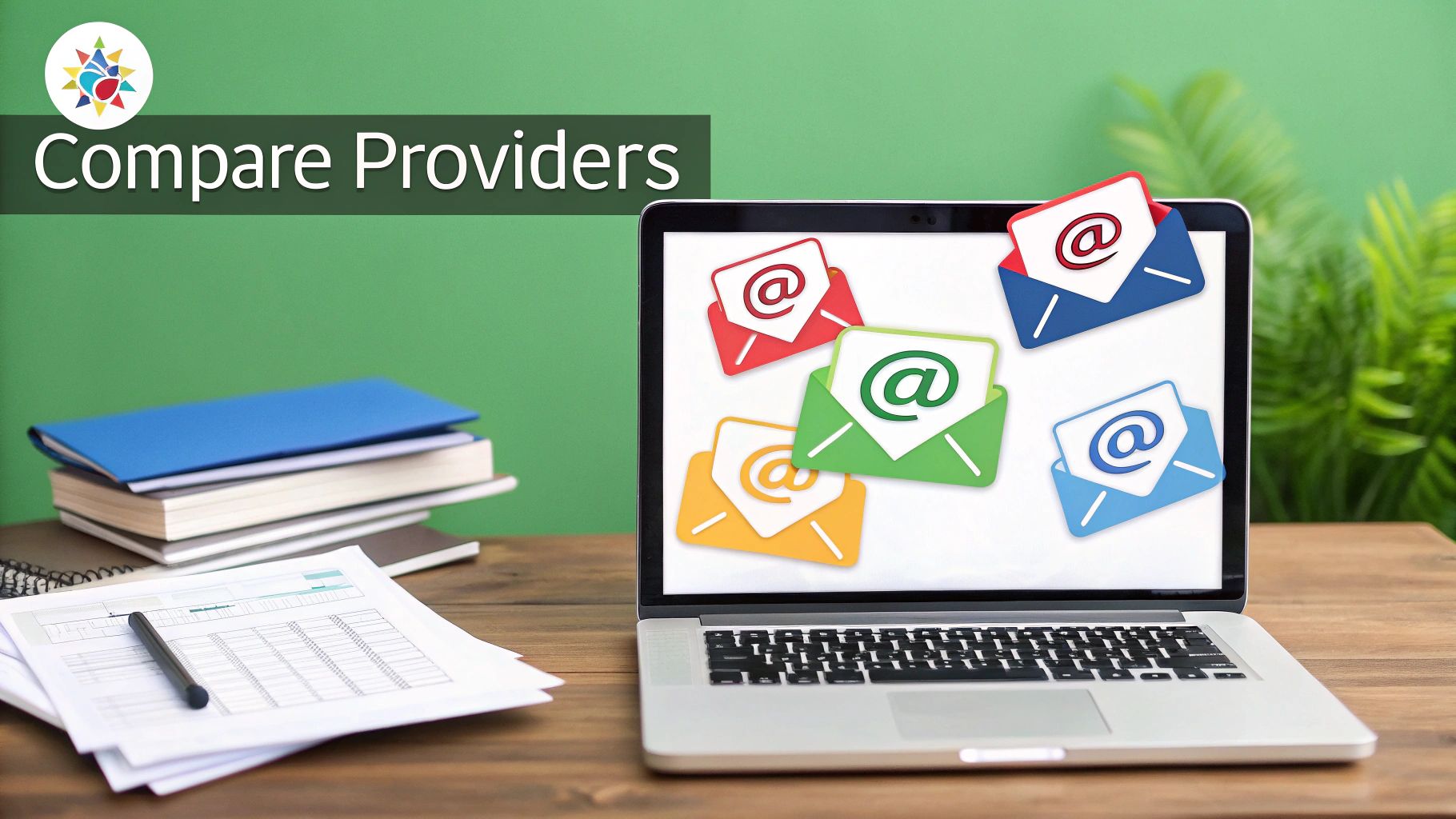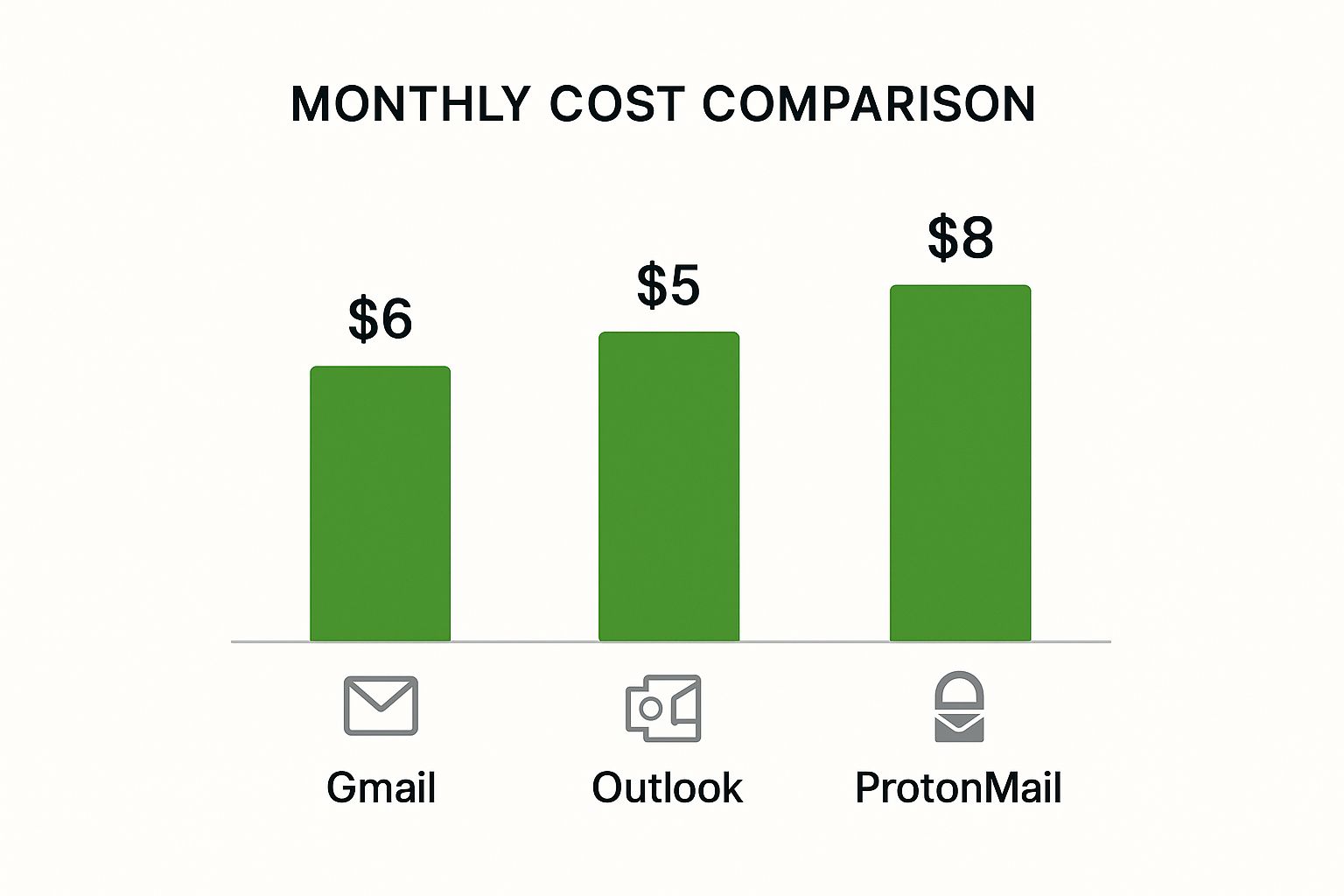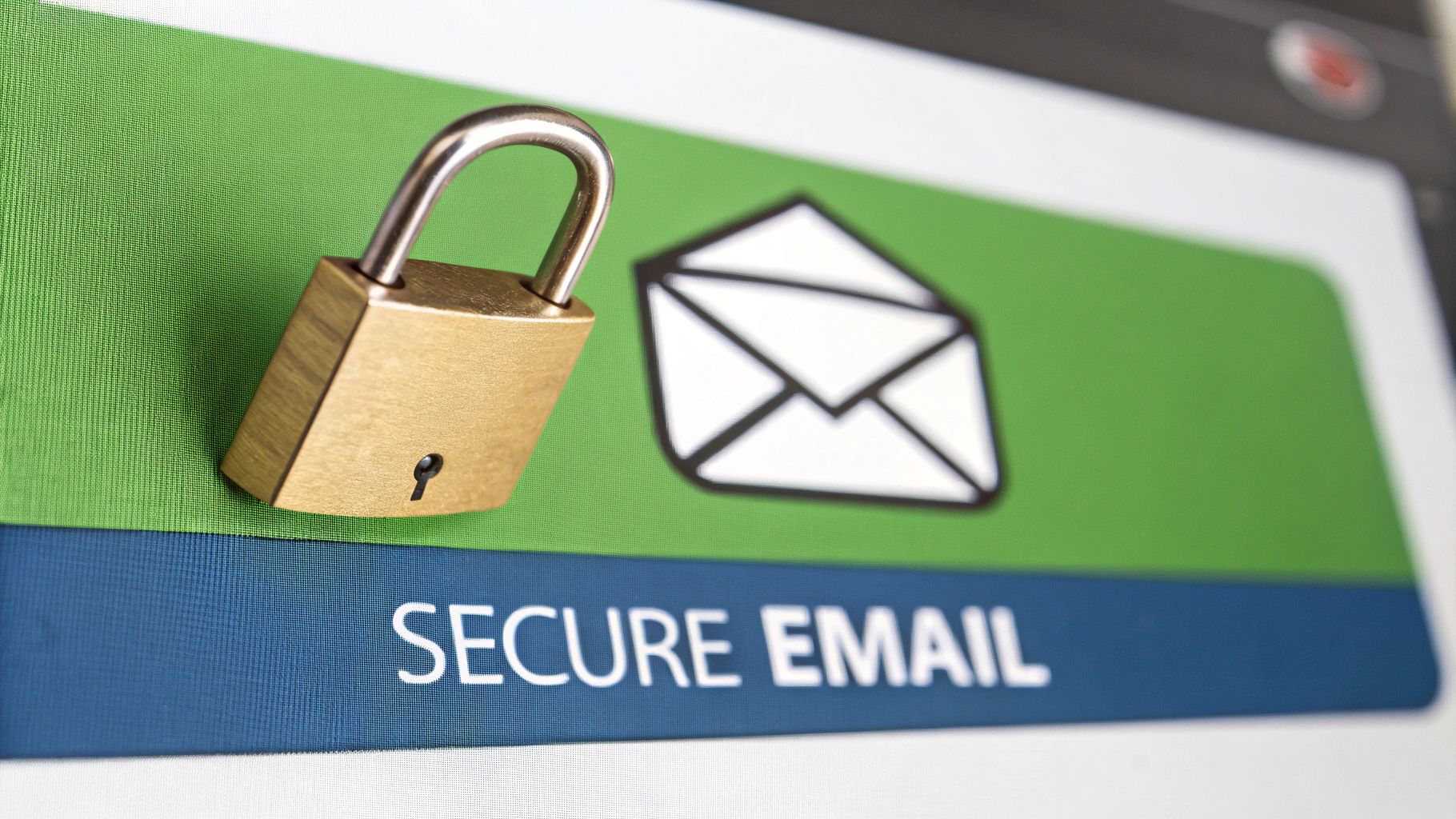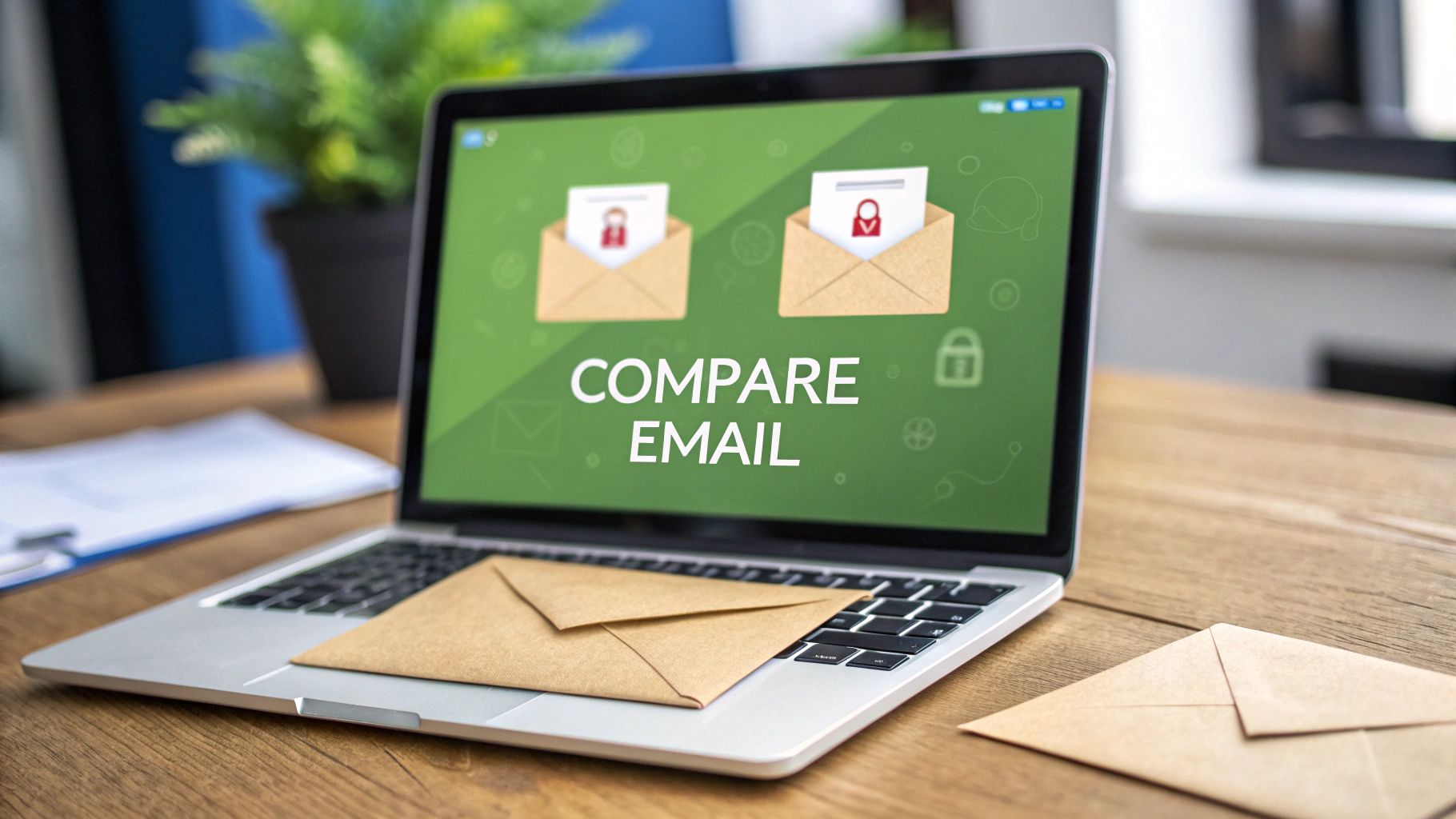When you start comparing email providers, you quickly realize there isn't one "best" choice for everyone. It all comes down to what you really need. If you live and breathe inside Google’s world, Gmail is a no-brainer with its deep ecosystem integration. Similarly, if your workday revolves around Microsoft 365, Outlook is the natural extension of that environment. But if your top priority is keeping your communications locked down and private, a service like Proton Mail is in a league of its own with its end-to-end encryption.
Choosing Your Best Email Provider

Finding the right email provider can feel overwhelming, but it gets a lot easier once you know what to look for. The market is really split into two camps: the massive, ad-supported platforms that offer incredible convenience, and the smaller, often paid services that put privacy above all else. Your decision ultimately boils down to what you value most—is it seamless integration, ironclad security, or professional business tools?
To cut through the noise, let's start with a high-level look at the top contenders. This quick-glance table breaks down the essentials to help you see which service aligns with your needs right away.
Top Email Providers at a Glance
A quick comparison of leading email services, focusing on core offerings to help you make a fast, informed decision based on your primary needs.
| Provider | Starting Price | Free Storage | Best For |
|---|---|---|---|
| Gmail | Free | 15 GB | Users deeply integrated into the Google ecosystem for seamless productivity. |
| Outlook | Free | 15 GB | Professionals and businesses that rely on Microsoft Office applications. |
| Proton Mail | Free | 1 GB | Individuals and organizations demanding the highest level of privacy and security. |
| Typewire | Free | 1 GB | Privacy-conscious users and businesses needing secure, ad-free communication with custom domains. |
This initial comparison tells a clear story. The giants like Google and Microsoft give you enormous storage and fantastic integration with their other apps, which is why they're the default for so many people. The catch? Their business models often depend on your data to personalize ads and services.
The real choice is between services that treat you as the customer versus those that treat you as the product. Privacy-first providers sell a service—secure email—while free providers often monetize your data.
On the other side of the fence, you have providers like Proton Mail and Typewire that have built their entire philosophy around user privacy. They bake in features like end-to-end encryption from the start and are based in countries with strong data protection laws. This intense focus on security means you get less free storage and fewer bells and whistles, but for many, that’s a trade-off worth making.
This split is even reflected in how people access their email. As of early 2025, Apple Mail dominates the client landscape, holding a massive 54-57% of the global market share, largely because it acts as a central hub for all kinds of email accounts. Gmail, however, isn't far behind, commanding between 27.7% and 31% of the market thanks to its powerful web and Android platforms. If you're curious, you can explore more insights about Gmail's user base and its position in the market.
Decoding What Matters in an Email Service
To really compare email providers, you first have to know what you’re looking for. It's easy to get lost in marketing hype, but if you don't have a solid grasp of the core features, you're just comparing flashy ads. Breaking down the essentials helps you find a service that fits your actual needs, not just what a company wants to sell you.
We live on our phones, and email is no exception. With around 4.48 billion email users across the globe, mobile access isn't just a feature—it's the standard. A staggering 61% of people prefer checking their email on a smartphone or tablet. For more than half of us (55.2%), it’s the very first thing we do online each day. This mobile-first world means a provider's app performance and design are more critical than ever. You can dig deeper into current email usage trends to see how these behaviors are shaping the entire industry.
Storage and Its Real-World Impact
Storage is often the headline feature, but the gigabytes advertised don't tell the whole story. A free 15 GB plan from a big-name provider sounds great on paper, but that space is usually shared across all their products—your cloud drive, photo backups, and more. A few large video files or a project backup can eat through that "generous" allowance in no time.
Your personal habits are what really matter here:
- The Digital Hoarder: If you save every email and get tons of attachments, you'll need a service with a hefty, dedicated email inbox or at least an affordable upgrade plan.
- The Inbox Minimalist: If you keep a tidy inbox and mostly send text, the smaller 1-5 GB limits found on many privacy-focused services will likely be more than enough.
Don't just think of storage as a number. Think of it as your digital filing cabinet. If you're storing important business records or personal memories, you need to be sure you have enough room and that it's reserved exclusively for your email.
A provider's storage limit is less about the number and more about the context. A 5 GB dedicated email inbox can be far more useful than a 15 GB shared pool if you're a heavy user of other cloud services from the same company.
Unpacking Security and Privacy
Security and privacy aren't the same thing, and it's crucial to understand the distinction when you compare email providers. Security is about keeping others out of your account. Privacy is about what the provider itself does with your data.
Key Security Features to Look For:
- Two-Factor Authentication (2FA): This is your best defense against unauthorized access. By requiring a code from your phone along with your password, it adds a powerful second layer of protection. Honestly, it should be considered non-negotiable for any important account.
- End-to-End Encryption (E2EE): This is the gold standard for secure communication. E2EE ensures only you and your recipient can read an email's contents—not even the provider can decrypt it. It’s a signature feature of services like Proton Mail and Typewire.
Privacy, on the other hand, comes down to the company's business model. "Free" email services are rarely free; they often scan your emails to build an advertising profile on you. A genuinely private service will have a crystal-clear policy against data mining and will be funded by subscriptions, not by selling your attention to advertisers.
Finally, think about your specific needs. For a business, custom domain support (like you@yourbusiness.com) is essential for building a professional brand. For a personal user, it’s probably an unnecessary expense. Looking at features through the lens of your own use case is the only way to find the perfect fit.
A Head-to-Head Analysis of Top Email Platforms
Alright, we’ve covered the fundamentals of a good email service. Now it’s time to put the top contenders under the microscope and see how they really stack up. To do this right, we have to look past the marketing fluff and dig into their real-world performance, features, and the trade-offs you'll inevitably make.
This analysis pits industry giants like Gmail and Outlook against privacy-first champions like Proton Mail and Tutanota. We’ll break down not just what they offer, but how their core philosophies shape the entire experience. From Gmail’s smart, integrated convenience to Proton Mail’s hardcore commitment to encryption, each one is built for a different kind of person.
Gmail: The Ecosystem King
Gmail is so much more than just an email app; it’s the central hub for the entire Google ecosystem. Its biggest strength is the absolutely seamless way it connects with Drive, Calendar, Docs, and Meet. If you live and breathe Google, this creates a fluid workflow that’s hard to beat.
And let's be honest, the search function is phenomenal. It’s a Google product, after all. Finding a specific email from years ago feels as natural as a web search. Plus, its AI features like Smart Compose and Smart Reply genuinely do shave off little bits of time throughout the day, which really adds up.
The catch? Your data is the price of admission. Gmail's business model hinges on analyzing user data to personalize services and, yes, ads. While Google no longer scans your email content for ads, it still collects a massive amount of metadata about your activity. For those who value convenience and deep integration above all else, Gmail is still a fantastic choice.
This chart gives you a quick visual of what you can expect to pay for the business tiers of our top contenders.

As you can see, Outlook comes in as the most budget-friendly for a basic business plan. Proton Mail, on the other hand, starts at a higher price point, which reflects its laser focus on premium privacy and security.
Outlook: The Professional’s Hub
Microsoft Outlook has been the gold standard in the corporate world for decades, and the modern version carries that legacy forward into a powerful tool for everyone. Like Gmail, its main advantage comes from integration, but its focus is squarely on the Microsoft 365 suite—Word, Excel, PowerPoint, and especially Teams. For professionals who spend their day jumping between these tools, Outlook just works.
Its calendar is arguably the standout feature. It’s packed with robust scheduling tools that are simply more advanced than most of the competition. I’ve also found that its "Focused Inbox" does a better job of separating important messages from junk than Gmail’s tabbed system. Security is also solid, with advanced threat protection available on its paid business plans.
The trade-off here is similar to Gmail’s, though maybe not as pronounced. As a core part of the Microsoft ecosystem, your data is collected to improve their services. While it's an incredible productivity machine, it wasn't built with a privacy-first mindset. If you’re running a small business, you might also want to check out our guide on the 7 best small business email service providers in 2025 for more tailored options.
Proton Mail: The Privacy Fortress
Proton Mail was built from the ground up for one reason: total privacy and security. It’s based in Switzerland, which means it’s protected by some of the world's strongest privacy laws. Its killer feature is automatic end-to-end encryption (E2EE) for every email sent between Proton users. That means nobody—not even the folks at Proton—can read your messages.
When you email someone who isn't on Proton, you can send password-protected, self-destructing messages to keep things secure. The platform is also open-source and independently audited, which adds a layer of transparency you just don't get from the big players.
Choosing Proton Mail is an active decision to prioritize privacy over convenience. You trade seamless integration with popular apps for the peace of mind that comes with knowing your communications are truly private.
The user experience is clean and modern, but don't expect the deep ecosystem connections you get from Google or Microsoft. The free plan is intentionally limited to 1 GB of storage to encourage users to upgrade. That’s how they fund the service—through subscriptions, not by selling your data. Proton Mail is the go-to for journalists, activists, and anyone who simply believes their email should be for their eyes only.
Tutanota: The Secure Alternative
Like Proton Mail, Tutanota is a German-based provider obsessed with secure, private email. It also provides end-to-end encryption for internal messages and has options for securing emails to external contacts. The key difference is that Tutanota encrypts everything—the email body, attachments, the subject line, and even your contact list.
Tutanota is also open-source and funded by user subscriptions. Its commitment to privacy is absolute, with a strict no-logs policy and servers located in Germany, which has stringent data protection laws. The interface is minimalist and functional, designed for security over flash.
Deciding between Proton Mail and Tutanota often boils down to personal preference. Some might be drawn to Tutanota's more comprehensive encryption, while others will prefer Proton's slightly more polished interface and its growing suite of privacy tools like Proton Drive and Calendar. Both are fantastic choices for anyone looking to de-Google their digital life.
Yahoo Mail: The Legacy Contender
Yahoo Mail is still a major player, mostly because of users who’ve had their accounts for ages. Its biggest selling point is the ridiculously generous 1 TB of free storage. That's far more than any competitor offers on a free plan. The interface has been modernized and includes decent organizational tools.
However, Yahoo's reputation has been tarnished by massive data breaches and a business model that relies heavily on scanning your emails for targeted ads. While its security has improved, its track record on privacy is pretty weak compared to almost everyone else on this list.
For a casual user who just needs a ton of free storage and isn't worried about data privacy, Yahoo Mail can work. But for any kind of business or sensitive communication, it’s just tough to recommend.
Feature Breakdown Gmail vs Outlook vs Proton Mail
To make this even clearer, let's put the top three side-by-side. This table really highlights where each provider shines and what compromises you're making with each choice.
| Feature | Gmail | Outlook | Proton Mail |
|---|---|---|---|
| Primary Strength | Unmatched ecosystem integration and AI-powered features. | Deep integration with Microsoft 365 and superior calendar functionality. | Uncompromising end-to-end encryption and a zero-knowledge privacy model. |
| Free Storage | 15 GB (shared with Drive, Photos) | 15 GB (dedicated to mail), 5 GB OneDrive | 1 GB (dedicated to mail) |
| Security Model | Strong, but data is scanned for service personalization. | Robust security features, especially in paid tiers. Data used for service improvement. | End-to-end encryption by default; zero-knowledge architecture. |
| Ideal User | Individuals and businesses heavily reliant on Google services. | Professionals and companies embedded in the Microsoft Office ecosystem. | Privacy-conscious individuals, journalists, and secure businesses. |
| Business Model | Advertising and Google Workspace subscriptions. | Microsoft 365 subscriptions. | User subscriptions (paid plans). |
This direct comparison really clarifies the core value of each service. Forecasts suggest that by 2025, a mind-boggling 376.4 billion emails will be sent across the globe every single day. Given Gmail's dominant market share, it's expected that over 130 billion of those daily emails will pass through its servers—a scale driven entirely by its deep integration. Your choice really comes down to this: do you want the convenience that drives that massive scale, or the privacy that defines a service like Proton Mail?
Matching the Right Email Service to Your Needs

Let's be clear: there's no single "best" email provider. The only thing that matters is finding the one that’s best for you. After you’ve weighed all the technical features, the final step is to see how they fit into your daily life. What works for a solo creative professional is worlds apart from what a growing e-commerce business needs.
This is where we connect the dots. I'll walk you through a few common scenarios to show how different priorities should lead you to different email providers. The goal is to help you feel confident in your final choice.
The Small Business Owner
For any small business owner, an email address is much more than a simple inbox—it's a core part of your brand and your operational backbone. Your focus isn't just on sending and receiving messages; it's on professionalism, teamwork, and growth.
Your priorities should look something like this:
- Custom Domain Support: Using an address like
contact@yourbusiness.comis non-negotiable. It instantly builds the trust and credibility that a generic@gmail.comsimply can't. - Integrated Suite of Tools: Efficiency is everything. A provider that bundles email with a shared calendar, cloud storage, and team chat apps—like Google Workspace or Microsoft 365—will save you countless hours.
- Scalability: You need a service that can grow with your business. Look for plans that make it painless to add new employees, increase storage, and manage multiple inboxes without a major technical headache.
Providers like Google Workspace and Microsoft 365 were built for this exact purpose. They offer the professional toolkit you need today and the scalability you'll need tomorrow. Once you've settled on a provider, our guide on how to switch email providers with a complete migration plan will help you make the move smoothly.
The Privacy-Focused User
If privacy is your main concern, your entire decision-making process gets turned on its head. You aren’t hunting for the most features or the slickest integrations. Instead, you're looking for the service that collects the absolute minimum amount of your data and locks down your communications.
Here’s your checklist:
- End-to-End Encryption (E2EE): This is the gold standard. E2EE guarantees that only you and your recipient can ever read your messages. The provider themselves can't access them.
- Zero-Knowledge Architecture: This means the provider has "zero knowledge" of your encryption keys. Even if legally compelled, they can't decrypt and hand over your stored emails.
- Secure Jurisdiction: The company should be based in a country with strong data privacy laws, like Switzerland or Germany, putting it outside the reach of broader surveillance agreements.
For the privacy advocate, the most important feature is the one you can't see: the company's core philosophy. You're not just buying an inbox; you're investing in a provider whose business model is built around protecting your privacy.
Services like Proton Mail and our own Typewire are designed from the ground up for this user. They're funded by subscriptions, not by selling or analyzing user data. The trade-off is often less free storage and fewer third-party integrations, but for anyone serious about privacy, it's a small price to pay for genuine peace of mind.
The Casual User in a Tech Ecosystem
Finally, we have the user who is already deeply invested in a particular tech ecosystem, whether it's Apple or Google. For you, the top priorities are convenience and seamless integration. Your email is the glue that holds your digital life together, connecting your calendar, photos, notes, and cloud storage.
The best choice here is almost always the provider that powers your ecosystem.
If you’re an iPhone, Mac, and iCloud user, Apple Mail offers an experience that’s simple, clean, and just works. If you live on an Android phone and use Google Docs and Photos daily, Gmail is the undeniable path of least resistance. These services are designed to work flawlessly together, creating an intuitive flow that feels effortless. The key is to recognize you're not just picking an email service—you're leaning into an entire platform.
Evaluating the True Value of Paid Email Plans

Free email is fantastic for personal use, but there comes a point where it just doesn’t cut it anymore. Deciding to upgrade isn't just about ditching ads or getting a bit more storage; it’s an investment in your professionalism, security, and overall efficiency. So, how do you figure out what you’re really getting for that monthly fee?
When you start digging into premium plans, you'll quickly realize the sticker price is just the tip of the iceberg. A $5/month plan might look better than a $6/month one at first glance, but you have to look deeper. Does that cheaper plan lock you into a yearly contract? Will they nickel-and-dime you for essentials like advanced spam filtering or actual human support?
Beyond the Inbox: Custom Domains and Branding
One of the most powerful and immediate perks of going paid is using a custom domain name. Let's be honest, an address like contact@yourbusiness.com just feels more legitimate and builds brand trust in a way a generic @gmail.com never could. It’s a small detail, but it speaks volumes about how seriously you take your work.
This is the entire premise behind business plans from Google Workspace and Microsoft 365. Their entry-level tiers, usually hovering around $5-$6 per user per month, aren’t just selling you an email account. They're providing a branded communication platform that becomes the foundation for your entire online presence.
The decision to pay for email is often less about the features themselves and more about what it signals. It tells the world your business is a serious, professional endeavor. It's a direct investment in your credibility.
Unlocking Advanced Security and Support
Paid plans are your ticket to much stronger security features. While two-factor authentication has become standard everywhere, premium services offer enhanced phishing and malware protection that can spot and neutralize a threat before it ever reaches your inbox. If you handle sensitive client or customer data, this added layer of security isn't a luxury—it's a necessity.
Take Proton Mail, for example. Their free service gives you excellent encryption right out of the box. But when you upgrade, you're paying for more storage, support for your own domain, and extra privacy tools. The value is crystal clear: you are funding a more robust security infrastructure. You can explore the top benefits of encrypted email you need to know to see why this is becoming such a high priority for so many.
On top of that, paying customers get to jump the line for support. When something goes wrong—and eventually, it will—having a direct line to a real support team can save you hours of headaches and costly downtime. It's a benefit that seems abstract until you're in a jam and desperately need it. As you compare providers, pay close attention to the level of support offered with each plan; it can be a massive differentiator.
Frequently Asked Questions About Email Providers
Even with a detailed comparison in hand, a few lingering questions can pop up when you're deciding on a new email service. Let's tackle some of the most common ones we hear from people trying to make the final call.
Is It a Hassle to Switch Email Providers?
The thought of moving years of emails, contacts, and calendar appointments can feel overwhelming, but it's usually much simpler than you'd think. Most modern email services have built-in migration tools designed for this exact purpose. With just a few clicks, you can authorize your new provider to pull everything over from your old account.
If you're bringing a custom domain over for your business, there are a couple of extra steps. You'll need to update your domain's MX records to point to the new service. Any good provider will have clear, step-by-step instructions to guide you. It's a one-time setup that's well worth the effort for the long-term benefits.
Are Free Email Services Actually Safe for Sensitive Information?
This is a big one, and the answer really comes down to what you mean by "safe." When it comes to security, mainstream services like Gmail and Outlook are top-notch. They do an excellent job protecting your account from being hacked, using strong tools like two-factor authentication and advanced spam filtering to keep bad actors out.
The catch is privacy. These free services often scan your data to personalize ads and other services. For truly sensitive information—think legal documents, financial records, or confidential business strategies—you're much better off with a service that offers end-to-end encryption.
Think of it this way: a free service puts a great lock on your front door. A private, encrypted service makes sure no one can listen to the conversations happening inside the house.
What's the Real Difference Between Security and Privacy?
This is a fundamental distinction that trips a lot of people up, but it's essential for making the right choice.
- Security is all about protecting your account from outside threats. It's the digital equivalent of locks, alarms, and security guards. We're talking about strong passwords, two-factor authentication (2FA), and malware scanning—all designed to stop someone from breaking in.
- Privacy is about how the email provider handles your data once it's in their system. A privacy-first provider promises not to scan your emails, sell your information, or track your activity for advertisers.
Simply put, security keeps hackers out, while privacy keeps the provider from snooping. As you compare email providers, you have to weigh both based on what you'll be using the account for.
Ready for an email experience that respects your privacy and gives you full control? Typewire offers secure, ad-free, and private email hosting with custom domain support and robust spam protection. Start your 7-day free trial today and see the difference.

